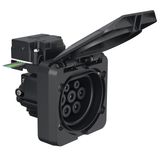PCE Charging cable E-Mobility










When your EV infrastructure project goes live, the cable linking the station to the vehicle is not a generic lead. With pce charging cable e mobility you specify an engineered cable assembly, fully certified for EV use, rated for repeated plugging cycles, under harsh outdoor or indoor conditions. These aren’t aftermarket cords—they’re part of the EV charging system, carrying high current (16–32 A+), ensuring safety, complying with IEC standards, and built to last thousands of uses.
PCE EV Charging Cables – Key Construction & Standards
pce ev charging cables are built for AC Mode 3 charging: typically 20 A or 32 A at 230 V (single-phase) or 3-phase 400 V systems. According to a PCE parts list they include Type 2 connectors for vehicle side, open end for station side, and comply with IEC 61851-1.
Important features:
- Cable cross-section commonly 3×6 mm² + 1×0.5 mm² signal for 32 A/22 kW applications.
- Sheath material: TPE-U or similar, halogen-free, cold-flexible to −30 °C, oil/UV resistant.
- Connector end: Type 2 (IEC 62196-2) widely used in Europe.
- Rated service-life: often >10 000 mating cycles at rated load
For procurement and specification, these details separate project-grade cables from generic ones.
PCE Type 2 Charging Wire – Selection Criteria & Use Cases
pce type 2 charging wire is the core link in accessible EV charging points: home wallboxes, apartment garages, public parking bays. When you specify, compare:
- Current rating: 16 A (≈3.7 kW) vs 32 A (≈7.4 kW) or 3-phase 32 A (≈22 kW).
- Cable length: e.g., 3 m, 5 m, 7.5 m; longer cables reduce voltage margin and may exceed bend or length limits.
- Connector durability: rated >10 000 cycles, mechanical strength tested in plug/unplug >100 N force.
- Compliance: IEC 62196-2, DIN/EN standard or automotive connector quality.
In residential fleets, a 32 A Type 2 cable saves time and provides future-proofing; in commercial multi-stall sites, you might specify tethered vs untethered cables, length, branding and weather protection.
PCE Electric Vehicle Cable – Installation & Maintenance Notes
When using pce electric vehicle cable in field applications:
- Mount so the cable hangs free or on a retractable arm to avoid sharp bends or floor drag; minimum bending radius typically 4× cable diameter static, 7.5× dynamic
- For outdoor parking: check IP rating of connector when plugged in, e.g., IP44 when mated, additional dust cap when not in use.
- On site, inspect for sheath cuts, avis signs of damage, confirm proximity pilot resistor value (≈220 Ω for healthy cable).
- Track cable batch numbers and length specifications for warranty and future replacements; mixed batches may differ in flexibility or connector feel.
These practices reduce downtime and extend cable service life in busy EV-charging zones.
Procurement & Partnership Benefits with Bank of Lamps
Buying pce charging cables through Bank of Lamps gives you:
- Genuine PCE cables with full certification (IEC 61851-1, IEC 62196-2) from verified stock.
- Volume pricing suited for EV infrastructure roll-outs (multi-stall garages, fleet depots).
- Real-time stock visibility and consolidated shipment of wallboxes plus cables to one site.
- Batch traceability for maintenance and audit records: we provide datasheets, batch codes, compatibility sheets.
- Logistics: EU-dispatch from our Latvia hub, with VAT-ready invoices and consolidated accessory packs (stands, cable hooks, signage).